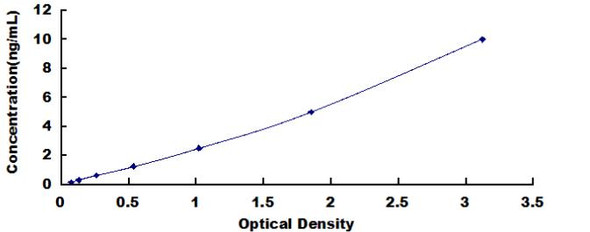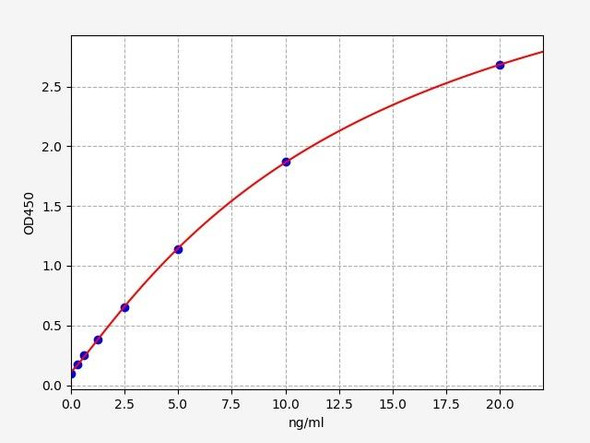Human Epigenetics and Nuclear Signaling ELISA Kits
Human TAF13 (TATA Box Binding Protein Associated Factor 13) CLIA Kit (HUES00563)
- SKU:
- HUES00563
- Product Type:
- ELISA Kit
- ELISA Type:
- CLIA Kit
- Size:
- 96 Assays
- Sensitivity:
- 37.5pg/mL
- Range:
- 62.5-4000pg/mL
- ELISA Type:
- Sandwich
- Reactivity:
- Human
- Sample Type:
- Serum, plasma and other biological fluids
- Research Area:
- Epigenetics and Nuclear Signaling
Description
| Assay type: | Sandwich |
| Format: | 96T |
| Assay time: | 4.5h |
| Reactivity: | Human |
| Detection method: | Chemiluminescence |
| Detection range: | 62.50-4000 pg/mL |
| Sensitivity: | 37.50 pg/mL |
| Sample volume: | 100µL |
| Sample type: | Serum, plasma and other biological fluids |
| Repeatability: | CV < 15% |
| Specificity: | This kit recognizes Human TAF13 in samples. No significant cross-reactivity or interference between Human TAF13 and analogues was observed. |
This kit uses Sandwich-CLIA as the method. The micro CLIA plate provided in this kit has been pre-coated with an antibody specific to Human TAF13. Standards or samples are added to the appropriate micro CLIA plate wells and combined with the specific antibody. Then a biotinylated detection antibody specific for Human TAF13 and Avidin-Horseradish Peroxidase (HRP) conjugate are added to each micro plate well successively and incubated. Free components are washed away. The substrate solution is added to each well. Only those wells that contain Human TAF13, biotinylated detection antibody and Avidin-HRP conjugate will appear fluorescence. The Relative light unit (RLU) value is measured spectrophotometrically by the Chemiluminescence immunoassay analyzer. The RLU value is positively associated with the concentration of Human TAF13. The concentration of Human TAF13 in the samples can be calculated by comparing the RLU of the samples to the standard curve.
| UniProt Protein Function: | TAF13: a TBP-associated factor (TAF). A component of TFIID complexes composed of the TATA binding protein (TBP), TAF10 and TAF11. TAF13 and TAF10 contain non-canonical histone folds, forming a histone-like pair in TFIID complexes. |
| UniProt Protein Details: | Protein type:Translation Chromosomal Location of Human Ortholog: 1p13. 3 Cellular Component: nucleoplasm; transcription factor TFIID complex; nucleolus; nucleus Molecular Function:protein C-terminus binding; protein binding; DNA binding; protein heterodimerization activity; transcription cofactor activity; transcription factor activity Biological Process: regulation of transcription from RNA polymerase II promoter; transcription from RNA polymerase II promoter; transcription initiation from RNA polymerase II promoter; viral reproduction; RNA elongation from RNA polymerase II promoter; transcription initiation; gene expression |
| NCBI Summary: | Initiation of transcription by RNA polymerase II requires the activities of more than 70 polypeptides. The protein that coordinates these activities is transcription factor IID (TFIID), which binds to the core promoter to position the polymerase properly, serves as the scaffold for assembly of the remainder of the transcription complex, and acts as a channel for regulatory signals. TFIID is composed of the TATA-binding protein (TBP) and a group of evolutionarily conserved proteins known as TBP-associated factors or TAFs. TAFs may participate in basal transcription, serve as coactivators, function in promoter recognition or modify general transcription factors (GTFs) to facilitate complex assembly and transcription initiation. This gene encodes a small subunit associated with a subset of TFIID complexes. This subunit interacts with TBP and with two other small subunits of TFIID, TAF10 and TAF11. There is a pseudogene located on chromosome 6. [provided by RefSeq, Jul 2008] |
| UniProt Code: | Q15543 |
| NCBI GenInfo Identifier: | 119576759 |
| NCBI Gene ID: | 6884 |
| NCBI Accession: | EAW56355. 1 |
| UniProt Secondary Accession: | Q15543,Q5TYV6, B2R5E5, |
| UniProt Related Accession: | Q15543 |
| Molecular Weight: | 14,287 Da |
| NCBI Full Name: | TAF13 RNA polymerase II, TATA box binding protein (TBP)-associated factor, 18kDa, isoform CRA_a |
| NCBI Synonym Full Names: | TAF13 RNA polymerase II, TATA box binding protein (TBP)-associated factor, 18kDa |
| NCBI Official Symbol: | TAF13 |
| NCBI Official Synonym Symbols: | TAF2K; TAFII18; TAFII-18; TAF(II)18 |
| NCBI Protein Information: | transcription initiation factor TFIID subunit 13; transcription initiation factor TFIID 18 kD subunit; transcription initiation factor TFIID 18 kDa subunit; TATA box binding protein (TBP)-associated factor, RNA polymerase II, K, 18kD |
| UniProt Protein Name: | Transcription initiation factor TFIID subunit 13 |
| UniProt Synonym Protein Names: | Transcription initiation factor TFIID 18 kDa subunit |
| Protein Family: | Transcription initiation factor |
| UniProt Gene Name: | TAF13 |
| UniProt Entry Name: | TAF13_HUMAN |
As the RLU values of the standard curve may vary according to the conditions of the actual assay performance (e. g. operator, pipetting technique, washing technique or temperature effects), the operator should establish a standard curve for each test. Typical standard curve and data is provided below for reference only.
| Concentration (pg/mL) | RLU | Average | Corrected |
| 4000 | 53942 64220 | 59081 | 59046 |
| 2000 | 27528 28190 | 27859 | 27824 |
| 1000 | 14569 12399 | 13484 | 13449 |
| 500 | 6531 6679 | 6605 | 6570 |
| 250 | 3291 3195 | 3243 | 3208 |
| 125 | 1696 1466 | 1581 | 1546 |
| 62.50 | 726 784 | 755 | 720 |
| 0 | 35 35 | 35 | -- |
Precision
Intra-assay Precision (Precision within an assay): 3 samples with low, mid range and high level Human TAF13 were tested 20 times on one plate, respectively.
Inter-assay Precision (Precision between assays): 3 samples with low, mid range and high level Human TAF13 were tested on 3 different plates, 20 replicates in each plate.
| Intra-assay Precision | Inter-assay Precision | |||||
| Sample | 1 | 2 | 3 | 1 | 2 | 3 |
| n | 20 | 20 | 20 | 20 | 20 | 20 |
| Mean (pg/mL) | 215.92 | 504.85 | 1976.00 | 219.49 | 478.80 | 2115.10 |
| Standard deviation | 26.90 | 38.22 | 137.92 | 20.94 | 39.26 | 197.13 |
| C V (%) | 12.46 | 7.57 | 6.98 | 9.54 | 8.20 | 9.32 |
Recovery
The recovery of Human TAF13 spiked at three different levels in samples throughout the range of the assay was evaluated in various matrices.
| Sample Type | Range (%) | Average Recovery (%) |
| Serum (n=5) | 93-104 | 98 |
| EDTA plasma (n=5) | 87-99 | 94 |
| Cell culture media (n=5) | 86-99 | 93 |
Linearity
Samples were spiked with high concentrations of Human TAF13 and diluted with Reference Standard & Sample Diluent to produce samples with values within the range of the assay.
| Serum (n=5) | EDTA plasma (n=5) | Cell culture media (n=5) | ||
| 1:2 | Range (%) | 93-105 | 97-109 | 92-106 |
| Average (%) | 100 | 104 | 98 | |
| 1:4 | Range (%) | 97-108 | 93-109 | 87-97 |
| Average (%) | 102 | 100 | 92 | |
| 1:8 | Range (%) | 90-105 | 94-108 | 93-106 |
| Average (%) | 96 | 100 | 100 | |
| 1:16 | Range (%) | 92-106 | 88-101 | 97-113 |
| Average (%) | 99 | 95 | 105 |
An unopened kit can be stored at 4°C for 1 month. If the kit is not used within 1 month, store the items separately according to the following conditions once the kit is received.
| Item | Specifications | Storage |
| Micro CLIA Plate(Dismountable) | 8 wells ×12 strips | -20°C, 6 months |
| Reference Standard | 2 vials | |
| Concentrated Biotinylated Detection Ab (100×) | 1 vial, 120 µL | |
| Concentrated HRP Conjugate (100×) | 1 vial, 120 µL | -20°C(shading light), 6 months |
| Reference Standard & Sample Diluent | 1 vial, 20 mL | 4°C, 6 months |
| Biotinylated Detection Ab Diluent | 1 vial, 14 mL | |
| HRP Conjugate Diluent | 1 vial, 14 mL | |
| Concentrated Wash Buffer (25×) | 1 vial, 30 mL | |
| Substrate Reagent A | 1 vial, 5 mL | 4°C (shading light) |
| Substrate Reagent B | 1 vial, 5 mL | 4°C (shading light) |
| Plate Sealer | 5 pieces | |
| Product Description | 1 copy | |
| Certificate of Analysis | 1 copy |
- Set standard, test sample and control (zero) wells on the pre-coated plate and record theirpositions. It is recommended to measure each standard and sample in duplicate. Note: addall solutions to the bottom of the plate wells while avoiding contact with the well walls. Ensuresolutions do not foam when adding to the wells.
- Aliquot 100µl of standard solutions into the standard wells.
- Add 100µl of Sample / Standard dilution buffer into the control (zero) well.
- Add 100µl of properly diluted sample (serum, plasma, tissue homogenates and otherbiological fluids. ) into test sample wells.
- Cover the plate with the sealer provided in the kit and incubate for 90 min at 37°C.
- Aspirate the liquid from each well, do not wash. Immediately add 100µL of BiotinylatedDetection Ab working solution to each well. Cover the plate with a plate seal and gently mix. Incubate for 1 hour at 37°C.
- Aspirate or decant the solution from the plate and add 350µL of wash buffer to each welland incubate for 1-2 minutes at room temperature. Aspirate the solution from each well andclap the plate on absorbent filter paper to dry. Repeat this process 3 times. Note: a microplatewasher can be used in this step and other wash steps.
- Add 100µL of HRP Conjugate working solution to each well. Cover with a plate seal andincubate for 30 min at 37°C.
- Aspirate or decant the solution from each well. Repeat the wash process for five times asconducted in step 7.
- Add 100µL of Substrate mixture solution to each well. Cover with a new plate seal andincubate for no more than 5 min at 37°C. Protect the plate from light.
- Determine the RLU value of each well immediately.






